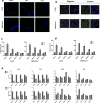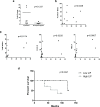Leukemia Inhibitory Factor Promotes Aggressiveness of Chordoma
- PMID: 28247842
- PMCID: PMC7841199
- DOI: 10.3727/096504017X14874349473815
Leukemia Inhibitory Factor Promotes Aggressiveness of Chordoma
Abstract
Chordomas are rare tumors of the spine and skull base that are locally destructive and resistant to chemotherapy and radiation therapy, with a poor prognosis and limited therapeutic options. Chordoma patients have a long life expectancy with high mortality from the disease. Cancer stem cells, which are known to exist in chordomas, have extensive proliferative and self-renewal potential and are responsible for maintaining tumor heterogeneity along with chemotherapy and radiotherapy resistance. Leukemia inhibitory factor (LIF) has multiple functions in stem cell biology, the immune response, and cancer, and is potentially a key molecule that allows cancer stem cells to self-renew. The purpose of this study was to determine whether LIF increases the aggressive traits of chordoma cells and leads to a poor prognosis in patients. Chordoma cell lines were treated with LIF, and functional tests were done. Twenty skull base chordoma samples were checked for levels of LIF and a correlation with clinicopathological features. The whole transcriptome microarray was used to observe changes in gene expression. We observed increased migration, invasion, tumorosphere formation, colony formation, epithelial-mesenchymal transition, and chemoresistance accompanied by a dramatic elevation in inflammatory gene networks and pathways in chordomas. The expression of LIF was associated with tumor size and a poorer overall survival. Microarray and quantitative real-time polymerase chain reaction assessments suggest that LIF can facilitate tumor-promoting inflammation. Results indicate that LIF plays a role in maintaining cancer stem cells in chordomas.
Conflict of interest statement
The authors declare no conflicts of interest.
Figures




References
-
- Almefty K, Pravdenkova S, Colli BO, Al-Mefty O, Gokden M. Chordoma and chondrosarcoma: Similar, but quite different, skull base tumors. Cancer 2007;110:2457–67. - PubMed
-
- Papagelopoulos PJ, Mavrogenis AF, Galanis EC, Savvidou OD, Boscainos PJ, Katonis PG, Sim FH. Chordoma of the spine: Clinicopathological features, diagnosis, and treatment. Orthopedics 2004;27:1256–63. - PubMed
-
- McMaster ML, Goldstein AM, Bromley CM, Ishibe N, Parry DM. Chordoma: Incidence and survival patterns in the United States, 1973–1995. Cancer Causes Control 2001;12:1–11. - PubMed
-
- Aydemir E, Bayrak OF, Sahin F, Atalay B, Kose GT, Ozen M, Sevli S, Dalan AB, Yalvac ME, Dogruluk T, Türe U. Characterization of cancer stem-like cells in chordoma. J Neurosurg. 2012;116:810–20. - PubMed
MeSH terms
Substances
LinkOut - more resources
Full Text Sources
Other Literature Sources
Molecular Biology Databases
Miscellaneous
